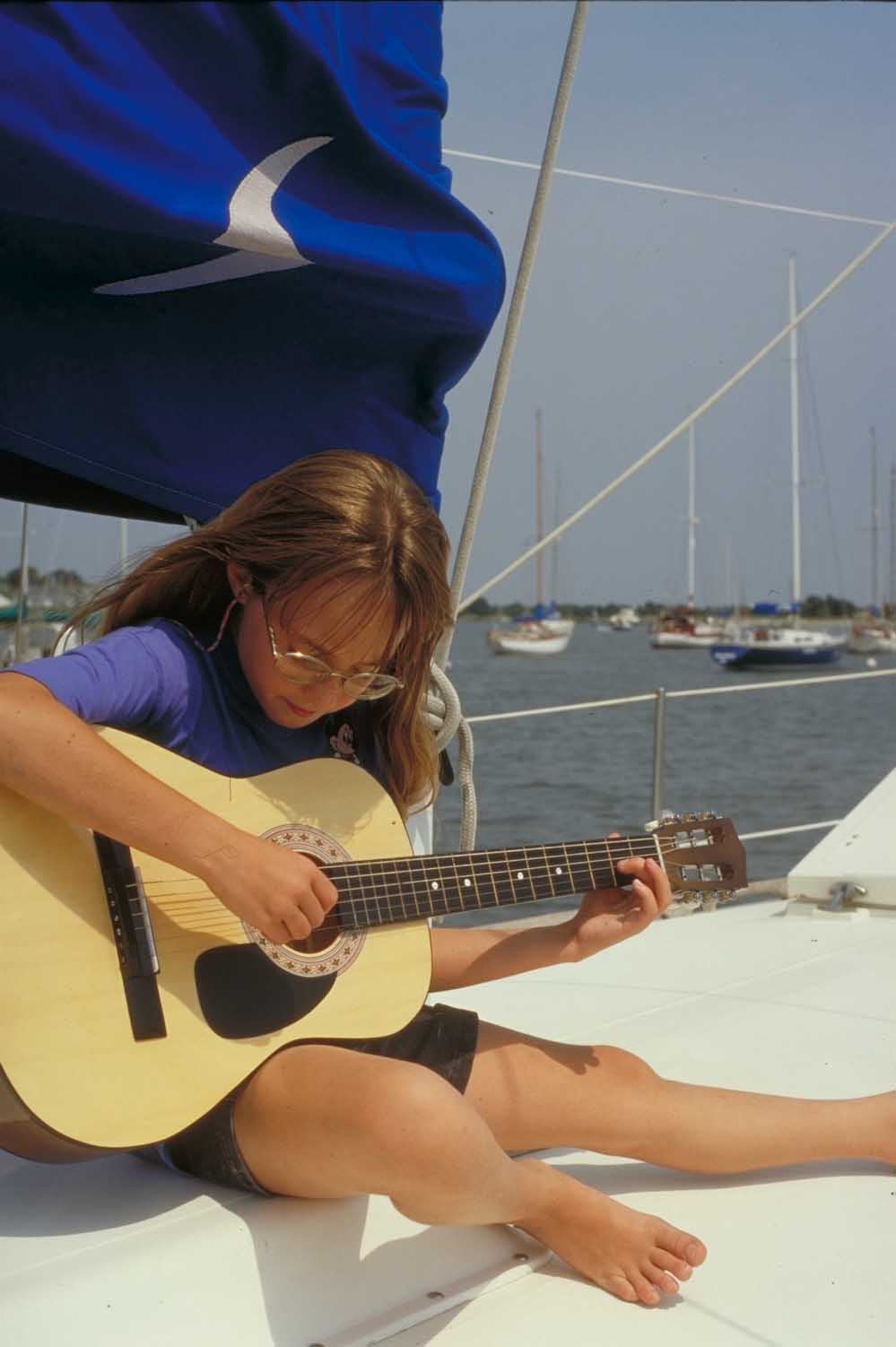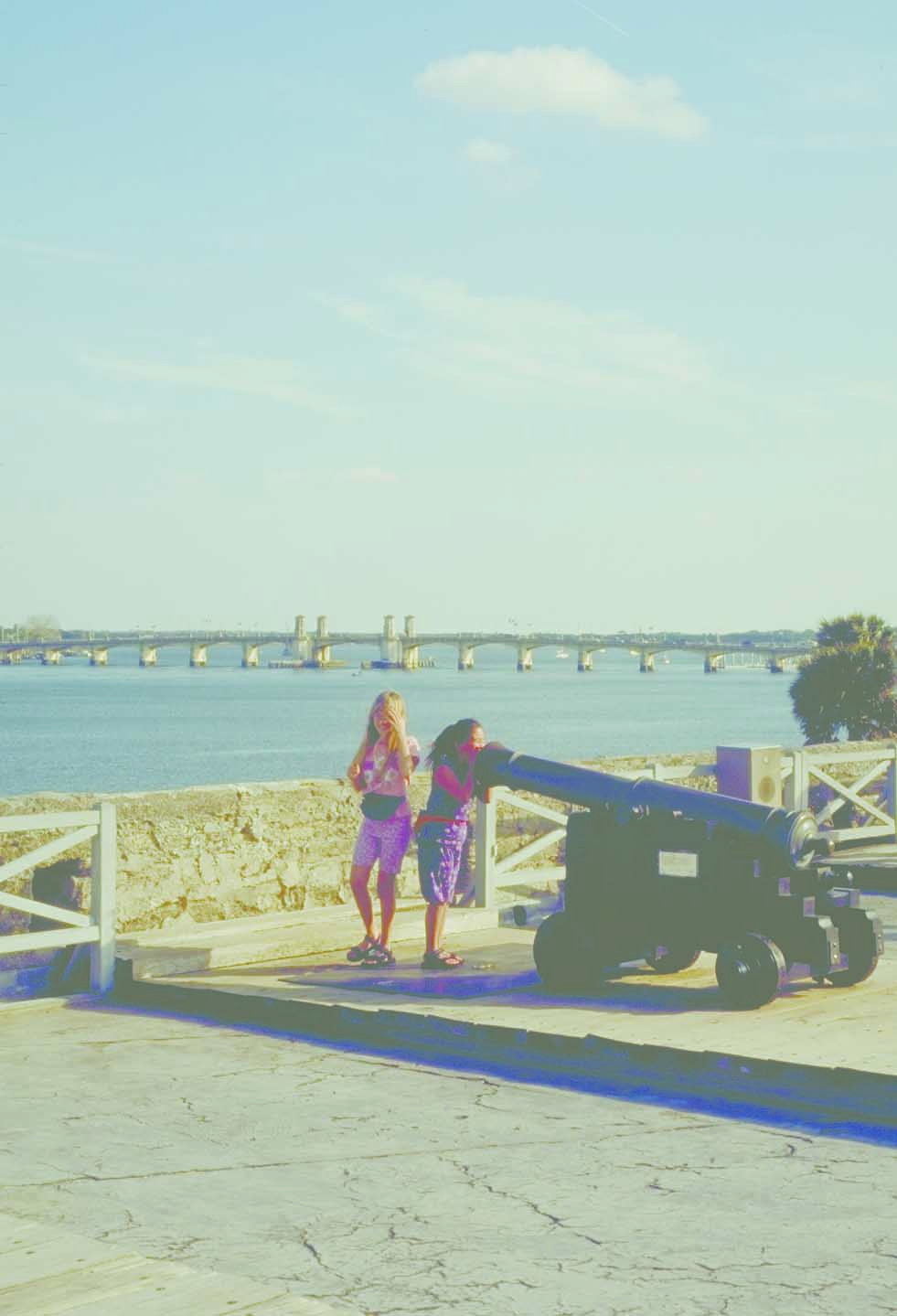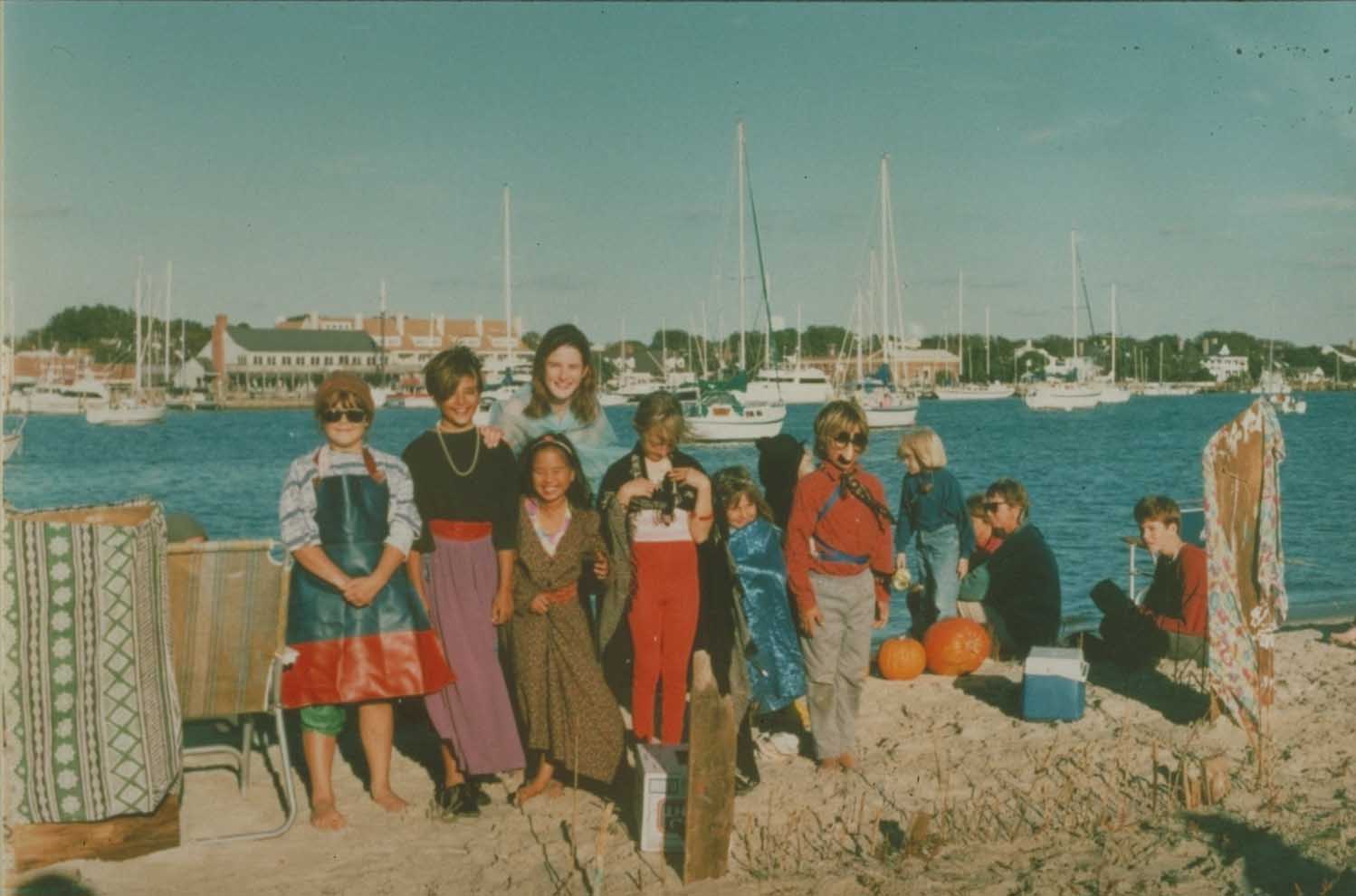
THE WORLD IS OUR CLASSROOM
by Barbara Theisen
I've never believed that the only way to get an education is to sit at a desk with four walls around you. The world is our classroom, and our home - a 41-foot sailboat - takes us there. My husband Tom and I dreamed of living aboard a sailboat before our daughters were even born. Their arrivals only increased our desire to live the "cruising lifestyle" - a way of life that has given us the opportunity for lots of quality and quantity of family time.
Educating our two daughters while living afloat has never posed any problems for us. Rather, it has added a wonderful new dimension to our lives. Kate (a gifted student) is in ninth grade this year and my youngest daughter Kenna is in seventh grade. For them learning is an adventure.
Homeschooling is on the rise in the United States. According to the U.S. Department of Education there were about 90,000 homeschooled children in 1983. Today it is estimated that there are about 1.5 million homeschoolers. There are many reasons for homeschooling. You're probably considering it because cruising will prevent your children from attending a "traditional" school. But many parents homeschool because they are frustrated by the poor quality of schools. They don't feel that the schools (public or private) are doing an adequate job of educating their children. Kids these days are also subject to a vast amount of peer pressure in the schools - peer pressure with serious consequences; gangs, drugs, sex, school violence, etc. Eight, ten and twelve-year-old kids are not mature enough to handle this daily pressure (many older kids are not either) and kids shouldn't have to be subjected to it.
 |
| Kate practices the guitar. |
Homeschooling your cruising kid can have great benefits. For a gifted student it can provide the chance to dive deep into a subject that interests her. A challenging curriculum tailored to your child's own interests can prevent boredom. For the average student homeschooling may provide the motivation to excel, to rise to their true abilities. For the student who has been one step behind in the classroom, it will provide the opportunity to develop and learn at his own pace. It will provide the much-needed one on one attention from you, the teacher. Homeschooling can mean success for your child and success builds self-confidence.
Homeschooling should be an advantage of your sailing getaway - not an excuse not to go!
Both sailing and traveling are educational in their own right but any parent who is contemplating a cruise - whether a one-year sabbatical or an extended cruise can greatly enhance the educational experience for their children. All it takes is a bit of homework beforehand. If you've never homeschooled before you might be surprised at your educational choices. The recent rise in the number of homeschoolers across the nation has in turn given rise to a great variety of choices in curriculums and materials geared specifically for homeschooling.
1. Correspondence Schools or Prepackaged Curriculums
Correspondence schools and prepackaged curriculums offer one of the easiest programs for parents who will be teaching their kids because the lesson plans and books are all there for you in one package. Calvert School www.calvertschool.org is the most popular with cruisers and their package comes complete with everything you will need for a particular grade, right down to pencil and paper. It is available for kindergarten through eighth grade. There are dozens of other schools offering complete courses, including Oak Meadow School, Pinewood School and for grades 6-12, Cambridge Academy. Kids and parents that I've spoken with are very pleased with many of these correspondence schools. For a complete list of correspondence schools check out The Homeschool Manual by Theodore Wade, Jr.
The biggest complaint cruisers have with correspondence schools is that they generally don't allow for much flexibility. Your cruising will take you on dozens of educational "field trips." But kids who partake in these not to be missed opportunities may end up taking a full twelve months or even two years to finish a grade of correspondence school.
Parents also complain that when using the teacher advisory service the time lag between sending in assignments and receiving grades and feedback is too long to be of much help (especially when traveling makes mail drops infrequent).
 |
| Kate and Kenna at the Mayan ruins of Tikal in Guatemala. |
Some parents mistakenly believe that if they choose to educate their children through a correspondence course or a prepackaged curriculum that they won't have to spend as much time "teaching." If you choose to homeschool your kids - you are their teacher. These courses will save you time because lesson plans are included, however you will still be doing the teaching. Some families start with a pre-packaged curriculum and adapt it to meet their needs. First time homeschoolers may want to start with a packaged curriculum until they have more confidence in their teaching abilities.
2. Set up your own curriculum.
Developing your own curriculum requires a bit more work before hand but is well worth the extra effort. You can tailor your lessons to take advantage of the places where you will be sailing to as well as your child's special interests. What child wouldn't want to dive into studies on the rain forest while cruising Central America or read Greek Mythology while sailing the Greek Isles? Devising your own curriculum also allows for plenty of flexibility. I also find that teaching two children (or more) is easier when I can combine some of our studies.
You might be wondering what to teach and when to teach it. A great book for this is Rebecca Rupp’s Home Learning Year by Year. Ask teachers for a copy of the school's curriculum guidelines. Theodore Wade's The Homeschool Manual gives a list of "Typical Course of Study" for kindergarten through 12th grade. Another source of information is The Core Knowledge Series, What Your (1st, 2nd, 3rd, 4th, 5th or 6th) Grader Needs To Know), published by Dell Publishing, $10.95 each in paperback. These sources list topics commonly studied at each grade level. For some subjects such as social studies and science, the grade at which a particular subject is studied can be varied so that both your third and sixth grader can study pioneer life or the solar system at the same time.
A popular approach used to explore a topic of interest in both homeschools and traditional schools is the "Unit Study." By using various disciplines such as reading, writing, science, history, geography, art, music, etc. you learn about your selected topic. You can even incorporate spelling and vocabulary by using words typical to that subject.
A great advantage of Unit Studies is that it's easy and fun to teach all of your children, even though they are of different ages. Topic ideas are endless - computers, sea mammals, weather, Medieval Times, explorers, the American Revolution, Mexican culture, herb gardening, fossils, etc. Some unit studies may last only a couple of days, others might last for a month or more.
Generally math will be taught separately as it can be difficult to integrate it into your unit study. But there are some wonderful math programs developed specifically for homeschools. Two favorites for homeschoolers are the Saxon Math program and Key Curriculum Press workbooks (Key to Decimals, Algebra, Fractions, Geometry, etc.) Be sure to supplement your textbook math with plenty of "hands-on math." This might include board games such as Monopoly, figuring out foreign money exchange rates, using the calculator and mental math skills, helping with the budget, etc. "Navigational" math is my kids' favorite way to put their math skills to practical use. How exciting to find out where in the world you are located by measuring angles of celestial bodies above the horizon or determining your position on a chart by calculating such things as speed, time traveled and compass course.
Most teachers or librarians will have a list of recommended literature for various reading levels. Use this list to help stock a good supply of reading materials.
Some good writing projects might include keeping a diary or a nature journal. My daughter Kate wrote, edited and published a monthly newsletter, the Out of Bounds Outburst for many years. She sent it to friends and relatives who were able to keep abreast of our sailing and school
activities.
3. Unschooling
About 15% of homeschoolers consider themselves to be Unschoolers. Unschooling is a word coined by educator John Holt, founder of Growing Without Schooling and is based on the belief that kids learn best when allowed to pursue their natural curiosities and interests. It is a “think for yourself” philosophy. Unschooling has come to mean a rather laid back, casual form of homeschooling, but there are unschoolers who use textbooks and a curriculum. For more information on unschooling check out www.unschooling.com or Mary Griffith The Unschooling Handbook.
Where do you start?
It's important for you, the teacher, to do your homework long before the start of the new school year. Start by calling for your free catalogs from book suppliers and/or correspondence schools (See sidebar for more information). Once you've made your choice, order early. I've found that many of the homeschooling book suppliers have plenty of stock during their busiest time - summer and early fall. But later in the year I had many items placed on back order for several weeks, which can be a real problem if you're in transit.
You will also need to get all of your other supplies such as paper, art materials, etc. Remember to stock up on a big supply of extracurricular reading materials. Most cruising kids become avid readers.
I also recommend having some books on tape. They're great to listen to in the cockpit while under way. We often listen to a chapter or two while washing dishes or doing some other chore as well. Tell friends and relatives that books on tape make a great gift. They are also available at many libraries. You and your kids may even enjoy making your own book on tape, complete with background sound effects, if you're really creative.
If you have a computer on board, there are some wonderful educational software programs available. I also recommend having an encyclopedia on CD-ROM aboard. Today's technology has put all those volumes of information into a size that will actually fit on your boat, as long as you have the power supply to run it.
Once you're cruising, remember that local librarians, historians and museum curators are a great educational resource. Be sure to find out about local festivals and special events such as art exhibits, historical reenactments, concerts, theater performances, nature seminars, etc.
School's In Session
Homeschooling requires some organization and some discipline. Its best to have a set time for schoolwork and stick to it as best you can. Plan on spending about an hour a day for a kindergartner, about two to three hours for primary grades and up to three or four hours a day for older children. Most families find that mornings are the preferred time for schoolwork.
We also have thirty to sixty minutes of SSR (sustained, silent reading) everyday that is not part of our morning school session. Everyone spends this time reading to themselves - whether a book, magazine, newspaper - whatever. Even non-reading young children should be involved in this. They can simply spend their time (perhaps only 15 minutes) looking at a picture book or other reading material. Seeing the importance of reading at an early age can really instill a life long love of it.
Part of the reason we cruise and homeschool are for the wonderful opportunities to learn about the world around us. Hands on learning experiences you get from hiking through a rainforest, snorkeling over a coral reef, visiting historic ruins, shopping in foreign markets or participating in local festivals should be an important part of your schooling.
Can You Teach Your Children?
One of the biggest fears facing parents new to homeschooling is whether they will be a good teacher. As a parent, you were your child's first teacher. You probably did a great job! How come somewhere along the way, someone convinced you that you weren't qualified to teach them beyond the preschool years?
 |
| History comes to life as Kate and Kenna explore a fort in St. Augustine, Florida. |
Homeschooling isn't easy. It will be a learning experience for you as well as your child. Fortunately there is help out there. Subscribe to a homeschooling magazine or talk with other homeschoolers. Attend homeschooling conferences or book fairs. There are also books available at your library that can help. Start learning before you actually untie the
docklines.
You may find that some of the teaching methods used in traditional schools are not necessarily the best methods and that other methods can be used in your homeschool. For example, workbooks are often used in traditional schools because this "busy work" keeps large numbers of students occupied while the teacher gives individual help to students. In your homeschool you may find busy work unnecessary, although drill work in math is still important. Individual instruction and less busy work is the reason that homeschoolers can accomplish a "full" day of school in only three or four hours. Some homeschoolers may also find that tests and grades are not as important as in traditional schools. Since there are a variety of philosophies and methods used by homeschoolers, you'll have to decide what will work best for you and your children.
The "S" Word
Another fear facing new homeschoolers is the 'S' word - socialization. Actually, most families who homeschool find that improved social skills are a benefit of homeschooling. A recent study showed that the self-concept of homeschoolers was significantly higher than that of public school students according to the Piers-Harris Children's Self Concept Scale - a test recognized as a good indicator of socialization.
If you (or your kids) are worried about the lack of socialization or lack of friends, rest assured. There is a cruising community of kids out there. Cruising kids gathered in one stop will often set up a "kids net" on the VHF. They will invite any new kids to join in as they make plans for their day's activities. Parents are thrilled as they see the kids "hit the books" in the morning so they can be done in time for the afternoon fun.
We look forward to the chance to get together with other homeschooled cruisers. One year we anchored and sailed for nearly four months with 7 children from three boats with another dozen or more kids from all parts of the world joining our group for several days or weeks at a time. The kids put on a play - doing everything from acting to making costumes and making a stage on a nearby island. We weren't invited to the dress rehearsal but as I peeked out the port I saw the young actors performing in front of half a dozen wild horses who happened to be grazing in front of the stage. The play was a big success, watched by 15 or so parents and friends and three dogs.
The kids found a local potter who invited them to try their hand at making pottery over a course of several afternoon sessions. A retired teacher (also living aboard) set up a creative writing class every Tuesday afternoon on one of the boats. As a group we took field trips to area museums. One of the mothers, a talented artist, took the kids for afternoons of sketching on the beach. Another parent, a world-renowned classical guitarist, was delighted with one of our daughter's interest in the guitar and took her under his wing with music lessons.
Social events come easily for cruising families. At Halloween my husband Tom brought a load of pumpkins to our potluck Halloween party on the beach. Cruising kids from various countries designed and carved their first jack-o-lantern. What a thrill as we lined the assortment of scary and humorous pumpkins up on the beach and lit their candles after dark.
 |
| The cast of Cinderella in full costume on the beach where they gave their performance. |
Along with our holiday celebrations there were birthday parties whose memories will last a lifetime. And of course there were plenty of dinghy races, soccer matches, and impromptu games that usually included pirates, treasures and mutinous crews of sailors - an important part of any cruising kid's education.
Wherever we sail, we discover new cultures to experience and new languages to learn. The girls use their math skills to help navigate. We have shelves full of books to read - kept fresh with recent book exchanges. There are experiments to observe, dolphins to spot, worlds to discover and dreams to follow. Best of all is the giggling of two young girls as they attempt to say hello to a new friend in a foreign language and realize that a smile is understood throughout the world.
I see that my children show love and concern for the creatures of this earth and for the environment. I see the respect that they show to all human beings and the joy in discovering different cultures. I see their love for learning. For us, cruising is definitely a dream worth following.
So whether you're taking a one year cruise or making cruising a way of life, make your dream an unforgettable education for your kids. The world can be your classroom.
Barbara Theisen has spent the past ten years living aboard Out of Bounds with her husband Tom and daughters, Kate and Kenna. For more information on cruising with kids visit the Theisen’s Website at www.TheCruisingLife.com.